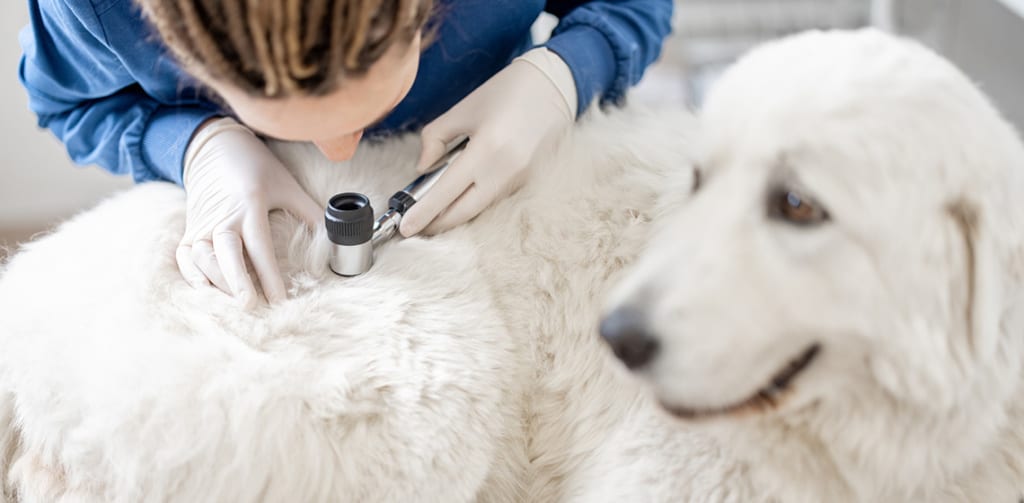There are many different types of skin problems in dogs, and some have multiple causes. A veterinarian can use various tests to find out what’s going on with your dog’s skin, whether it’s parasites, allergies, infection, or another reason. Once the cause is clear, there are specific treatments that can help.
Severity:
Can vary from mild to severe depending on the cause
Table of Contents
Key points
- Parasites, allergies, infections, and underlying health conditions can cause skin problems.
- Symptoms of skin problems include itchiness, redness, and hair loss, as well as scabs or red spots on the skin.
- To test your dog’s skin your vet might take a sample of hair, a skin scrape, a blood sample, or a skin biopsy.
- Treatment will depend on the diagnosis.
Common in
Skin problems can affect any dog and are one of the most common conditions seen by veterinarians.
Symptoms & types
Depending on what is causing the skin condition, your dog might show various symptoms. Parasite infestations like fleas or mites (mange) can cause intense itching and hair loss. Sometimes the hair loss is traumatic because all that scratching your poor pup is doing damages the hairs and hair follicles. However, there is a particular mite called Demodex, which lives in the hair follicles, and this can cause the hair to fall out. Parasites can also cause the skin to be sore and scabby, especially if your dog is licking and scratching a lot.
Fleas and allergic dermatitis are two of the most common skin conditions in dogs.
Skin problems caused by allergies can also cause itching, but they usually cause a rash too. You might notice the skin looks particularly red in areas like the armpit, groin, belly, feet, or under the chin. You might not expect it, but skin allergies are a common cause of ear infections, so you might notice your dog shaking their head or scratching their ears.
Bacterial or yeast infections might cause your dog’s skin to look scabby or crusty, and you might notice an unpleasant smell. Infections can also make your pooch very itchy, and the skin might be inflamed, with red or pus-filled spots. If your dog’s skin is inflamed long-term, the skin will become thickened, and you might notice it becoming darker in color – known as hyperpigmentation.
Understanding the diagnostics
To find out the underlying cause of your dog’s skin problem, there are a few tests that your veterinarian can do. They’ll probably start with a head-to-tail examination and by asking some questions about your pet’s health and lifestyle. They may comb through the fur with a fine-toothed comb to check for fleas and flea dirt. They can also send the coat brushings, along with hair plucks, to the lab to test for fungal conditions like ringworm.
Another way to look for parasites that may be hiding just under the skin’s surface is to perform a skin scrape, where the skin’s surface is scraped to remove layers of cells. These cells can be examined under the microscope to check for burrowing mites.
Because some underlying health conditions can cause skin issues, your veterinarian might suggest a general blood test to check your dog’s health. If they suspect an allergy might be the cause, they might recommend an allergy blood test or a hypoallergenic diet trial. Finally, if the reason for your dog’s skin problem is not apparent, they might suggest a minor operation to take a skin biopsy.
Learning about the causes
Allergies
One of the most common causes of skin issues is allergies, which can be frustrating because an allergy cannot be cured. Allergies in dogs could be to almost anything, including food, pollen, house dust mites, and fleas. Dogs with allergies can get really sore skin and infections due to self-trauma, so confirming the allergy is essential so that you can start to manage it properly.
Parasites
Thankfully, many parasites that live on the skin are visible to the naked eye. You might notice flea or flea dirt in your dog’s coat, and if your dog has a tick, you might feel it when you are stroking them. Mites can be a little more tricky since they are so small, and some of them burrow under the surface of the skin, but don’t worry, your veterinarian will be able to spot the signs and find them if they are lurking out of sight!
Infections
Ringworm is a fungal skin condition that can cause patches of hairless, scaly skin on your dog. It’s important to diagnose if your dog has ringworm because it is contagious to other animals and people. Cats can carry ringworm without showing any symptoms, so if your dog has developed bald spots and you have a cat, that could be the reason.
Infections can be caused when bacteria or yeast grow out of control on the skin. Sometimes this is due to an allergy or underlying health condition, but it can also happen if the skin barrier is damaged, allowing bacteria to penetrate
Most skin infections will clear up with antibiotics or antifungals. These treatments might be tablets, creams, or shampoos.
Best treatment options
The best treatment options for your dog’s skin problem will depend on the underlying cause.
- If your dog has allergies, trying to prevent exposure to the allergen is key. A hypoallergenic diet might be helpful if the allergy is to food, and strict flea treatment should help a flea allergy. However, other allergens like storage mites, house dust mites, and pollen are harder to control. Your veterinarian can control the allergy symptoms with medication, which is sometimes needed long-term.
- If your dog has a parasite problem, you can use treatments to banish the crawly critters. Depending on the parasite, treatments are available as a spray, tablet, or spot-on, but don’t forget to treat other pets and your house if it’s fleas!
- Ringworm is treated similarly, with a shampoo or medicated rinse. If you have symptoms, you should speak to your doctor.
Most skin infections will clear up with antibiotics or antifungals. These treatments might be tablets, creams, or shampoos, depending on which bug is causing your dog’s skin complaint.
If you’ve seen fleas, or you know that your dog is overdue for parasite treatment, it could be worth trying that first.
Home remedies & their effectiveness
Feeling itchy and irritated is unpleasant for your dog, so it’s best not to waste too much time trying to fix your pooch at home. If you’ve seen fleas, or you know that your dog is overdue for parasite treatment, it could be worth trying that first. However, if signs don’t improve after a couple of days, you should seek veterinary advice.
If your dog has open sores on their skin, using salt water to bathe the area until you can get to a vet will help keep it free from infection. You can also try to prevent self-trauma from scratching by using a cone collar or socks (but make sure your dog doesn’t eat them!).
When to see a vet
It’s pretty miserable having itchy, sore skin, so it’s best to make an appointment with your veterinarian if you notice your dog’s skin is bothering them. After all, some causes, like full anal glands, are quick and straightforward to fix if caught early. It’s also worth remembering that skin conditions can sometimes be a sign of an underlying health condition, like diabetes or Cushing’s disease, so seeing a veterinarian as soon as possible will allow a diagnosis to be made.
Summary
From fleas and mites to allergies and ear infections, all dogs are likely to get skin problems at some point in their lives. Skin problems can be frustrating for pet parents, as some causes can be difficult to resolve completely. Don’t worry, though; your veterinarian will be able to perform some tests and advise on the best treatment plan for your furry best friend.
FAQ
Fleas and allergic dermatitis are two of the most common skin conditions in dogs. Both can be frustrating, but for different reasons. Eradicating a flea infestation is time-consuming, but it can be done. You just need to treat the home, hot-wash soft furnishings, and treat all pets with a veterinary-approved flea treatment. Sadly, allergies cannot be cured, but that doesn’t mean your veterinarian can’t give medication and advice on lifestyle changes that will keep the allergy under control.
Before treating your dog’s skin problem, you need to find out the cause. Make an appointment with your veterinarian for them to examine your dog and help you get to the bottom of it.
Seborrheic dermatitis is when the skin becomes greasy and scurfy with dandruff. Occasionally it’s a genetic, lifelong problem for dogs, but it’s more commonly a symptom of other health issues like allergies.
Mange and allergies can both cause skin redness, itchiness, and hair loss. Your veterinarian will be able to test for an allergy by taking a blood sample. There is also a blood test for certain types of mange, but it is more commonly diagnosed by looking at a skin scrape sample under the microscope.

Dr. Hannah Godfrey MRCVS graduated from the Royal Veterinary College in 2011. Although she initially worked in mixed practice treating all species, she found a love for small animal work and has worked exclusively with dogs and cats since 2014. She lives in Wales with her partner, son, and two cats (named Poppy and Ashton Kutcher), and writes comedy fiction in her spare time.








